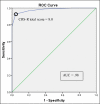Sensitivity and Specificity of the Coma Recovery Scale--Revised Total Score in Detection of Conscious Awareness
- PMID: 26342571
- PMCID: PMC5018674
- DOI: 10.1016/j.apmr.2015.08.422
Sensitivity and Specificity of the Coma Recovery Scale--Revised Total Score in Detection of Conscious Awareness
Abstract
Objective: To describe the sensitivity and specificity of Coma Recovery Scale-Revised (CRS-R) total scores in detecting conscious awareness.
Design: Data were retrospectively extracted from the medical records of patients enrolled in a specialized disorders of consciousness (DOC) program. Sensitivity and specificity analyses were completed using CRS-R-derived diagnoses of minimally conscious state (MCS) or emerged from minimally conscious state (EMCS) as the reference standard for conscious awareness and the total CRS-R score as the test criterion. A receiver operating characteristic curve was constructed to demonstrate the optimal CRS-R total cutoff score for maximizing sensitivity and specificity.
Setting: Specialized DOC program.
Participants: Patients enrolled in the DOC program (N=252, 157 men; mean age, 49y; mean time from injury, 48d; traumatic etiology, n=127; nontraumatic etiology, n=125; diagnosis of coma or vegetative state, n=70; diagnosis of MCS or EMCS, n=182).
Interventions: Not applicable.
Main outcome measures: Sensitivity and specificity of CRS-R total scores in detecting conscious awareness.
Results: A CRS-R total score of 10 or higher yielded a sensitivity of .78 for correct identification of patients in MCS or EMCS, and a specificity of 1.00 for correct identification of patients who did not meet criteria for either of these diagnoses (ie, were diagnosed with vegetative state or coma). The area under the curve in the receiver operating characteristic curve analysis is .98.
Conclusions: A total CRS-R score of 10 or higher provides strong evidence of conscious awareness but resulted in a false-negative diagnostic error in 22% of patients who demonstrated conscious awareness based on CRS-R diagnostic criteria. A cutoff score of 8 provides the best balance between sensitivity and specificity, accurately classifying 93% of cases. The optimal total score cutoff will vary depending on the user's objective.
Keywords: Brain injuries; Consciousness disorders; Rehabilitation; Sensitivity and specificity.
Copyright © 2016 American Congress of Rehabilitation Medicine. Published by Elsevier Inc. All rights reserved.
Figures

Similar articles
-
Rationale and design of the prospective German registry of outcome in patients with severe disorders of consciousness after acute brain injury.Arch Phys Med Rehabil. 2013 Oct;94(10):1870-6. doi: 10.1016/j.apmr.2012.10.040. Epub 2013 May 31. Arch Phys Med Rehabil. 2013. PMID: 23732165
-
A Spanish validation of the Coma Recovery Scale-Revised (CRS-R).Brain Inj. 2014;28(13-14):1744-7. doi: 10.3109/02699052.2014.947621. Epub 2014 Sep 29. Brain Inj. 2014. PMID: 25264811
-
Assessment of Nociception and Pain in Participants in an Unresponsive or Minimally Conscious State After Acquired Brain Injury: The Relation Between the Coma Recovery Scale-Revised and the Nociception Coma Scale-Revised.Arch Phys Med Rehabil. 2018 Sep;99(9):1755-1762. doi: 10.1016/j.apmr.2018.03.009. Epub 2018 Apr 10. Arch Phys Med Rehabil. 2018. PMID: 29653106
-
Chronic disorders of consciousness.Lancet. 2006 Apr 8;367(9517):1181-92. doi: 10.1016/S0140-6736(06)68508-5. Lancet. 2006. PMID: 16616561 Review.
-
Deep Brain Stimulation for Recovery of Consciousness in Minimally Conscious Patients After Traumatic Brain Injury: A Systematic Review.Neuromodulation. 2019 Jun;22(4):373-379. doi: 10.1111/ner.12944. Epub 2019 Mar 13. Neuromodulation. 2019. PMID: 30865342
Cited by
-
Proceedings of the First Curing Coma Campaign NIH Symposium: Challenging the Future of Research for Coma and Disorders of Consciousness.Neurocrit Care. 2021 Jul;35(Suppl 1):4-23. doi: 10.1007/s12028-021-01260-x. Epub 2021 Jul 8. Neurocrit Care. 2021. PMID: 34236619 Free PMC article.
-
Recovery of consciousness after acute brain injury: a narrative review.J Intensive Care. 2024 Sep 26;12(1):37. doi: 10.1186/s40560-024-00749-9. J Intensive Care. 2024. PMID: 39327599 Free PMC article. Review.
-
Bedside EEG predicts longitudinal behavioural changes in disorders of consciousness.Neuroimage Clin. 2020;28:102372. doi: 10.1016/j.nicl.2020.102372. Epub 2020 Aug 5. Neuroimage Clin. 2020. PMID: 32795964 Free PMC article.
-
Stroke survivor perceptions of using an exoskeleton during acute gait rehabilitation.Sci Rep. 2022 Aug 19;12(1):14185. doi: 10.1038/s41598-022-18188-7. Sci Rep. 2022. PMID: 35986162 Free PMC article.
-
Detection and Interpretation of Impossible and Improbable Coma Recovery Scale-Revised Scores.Arch Phys Med Rehabil. 2016 Aug;97(8):1295-1300.e4. doi: 10.1016/j.apmr.2016.02.009. Epub 2016 Mar 2. Arch Phys Med Rehabil. 2016. PMID: 26944708 Free PMC article.
References
-
- Medical Aspects of the Persistent Vegetative State. New England Journal of Medicine. 1994;330(21):1499–1508. - PubMed
-
- Giacino JT, et al. The minimally conscious state: definition and diagnostic criteria. Neurology. 2002;58(3):349–53. - PubMed
-
- Lammi MH, et al. The minimally conscious state and recovery potential: a follow-up study 2 to 5 years after traumatic brain injury. Arch Phys Med Rehabil. 2005;86(4):746–54. - PubMed
-
- Giacino JT, Kalmar K, Whyte J. The JFK Coma Recovery Scale-Revised: measurement characteristics and diagnostic utility. Arch Phys Med Rehabil. 2004;85(12):2020–9. - PubMed
Publication types
MeSH terms
Grants and funding
LinkOut - more resources
Full Text Sources
Other Literature Sources
Medical

